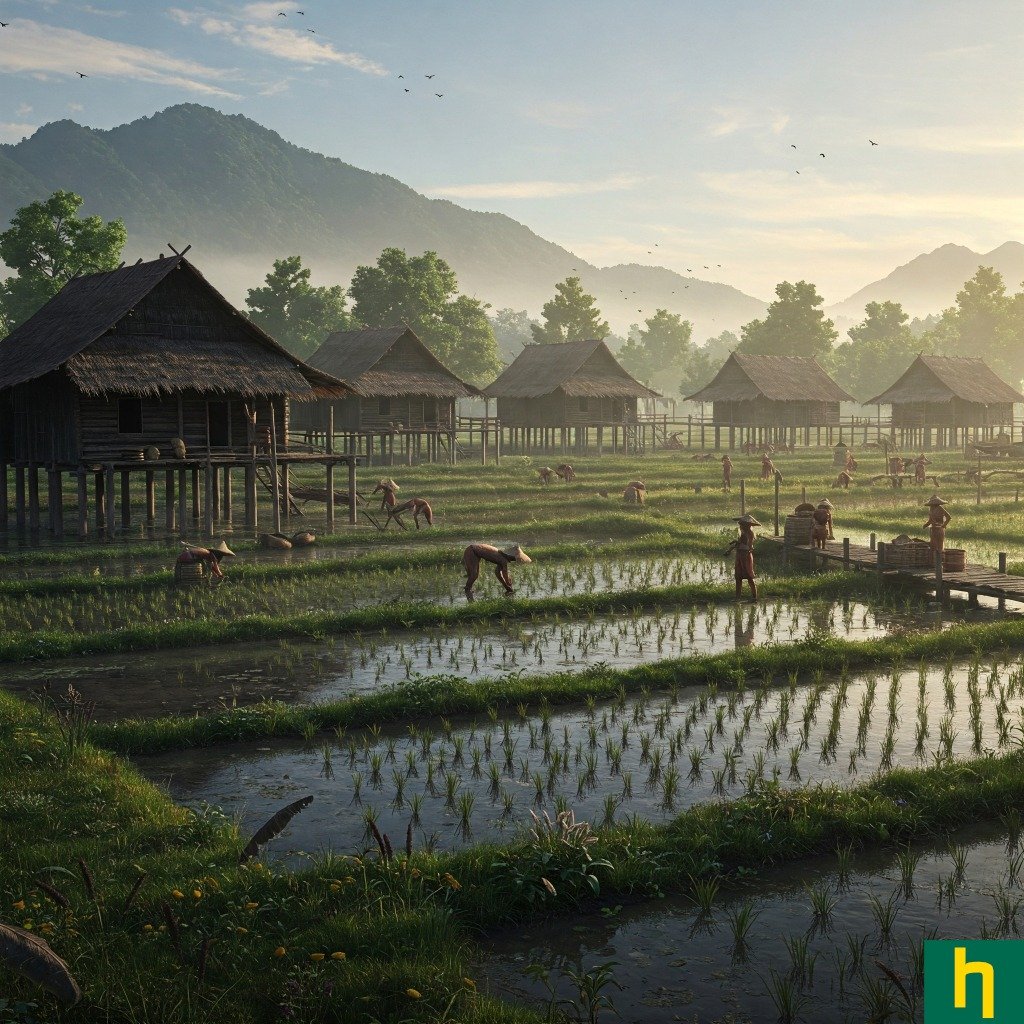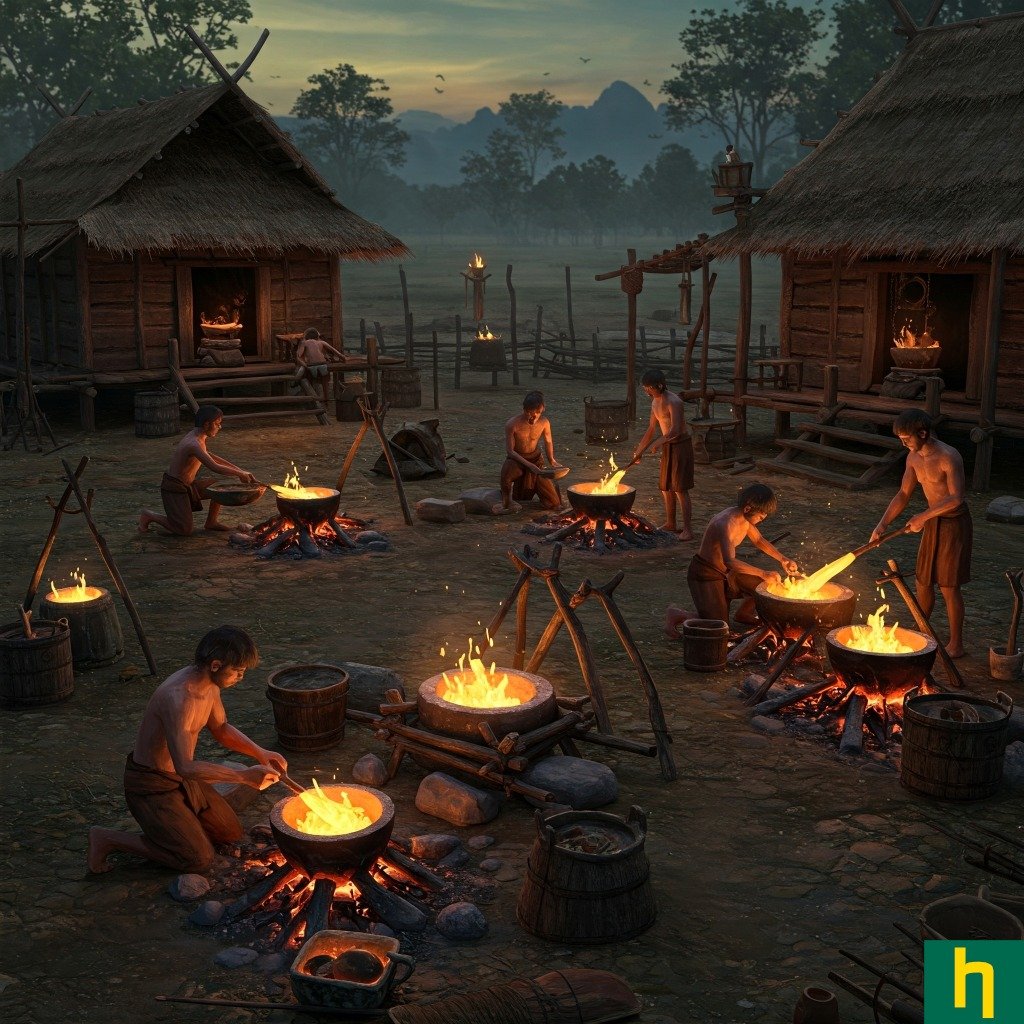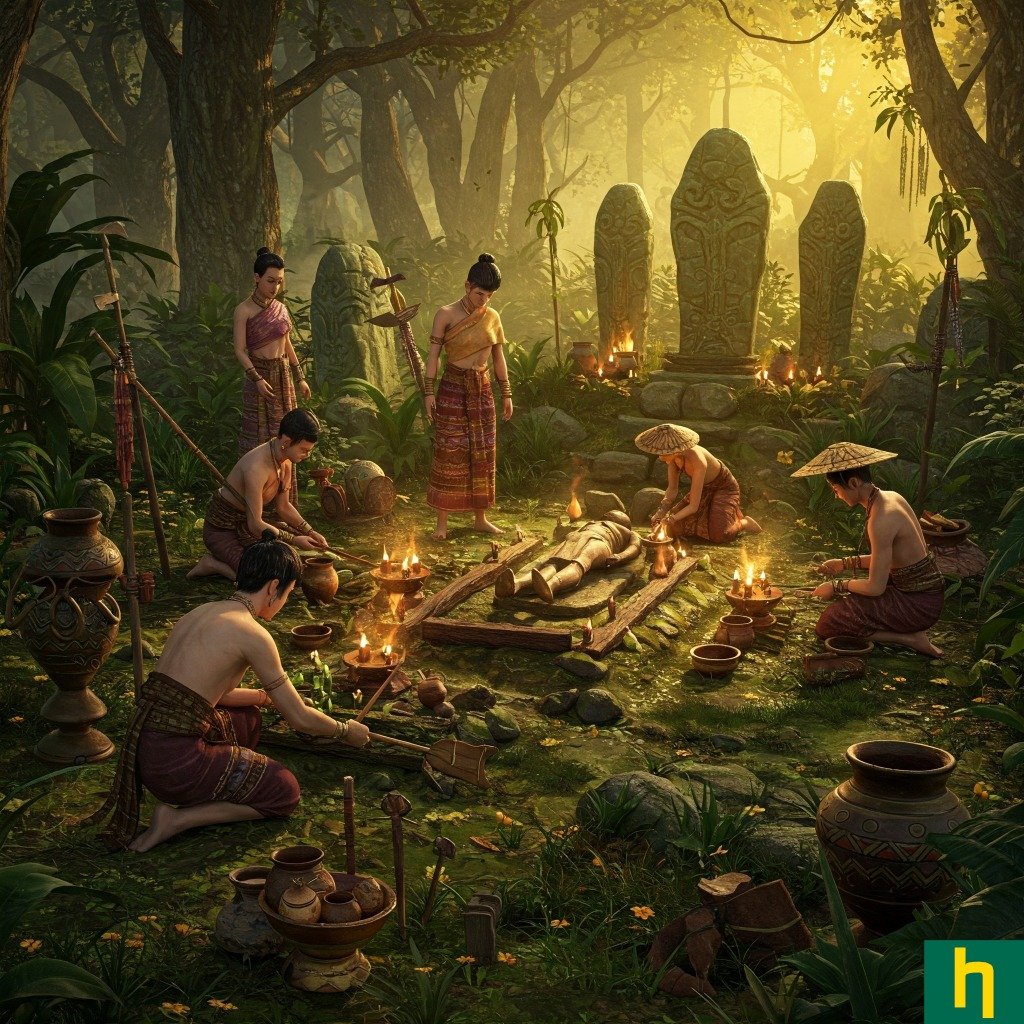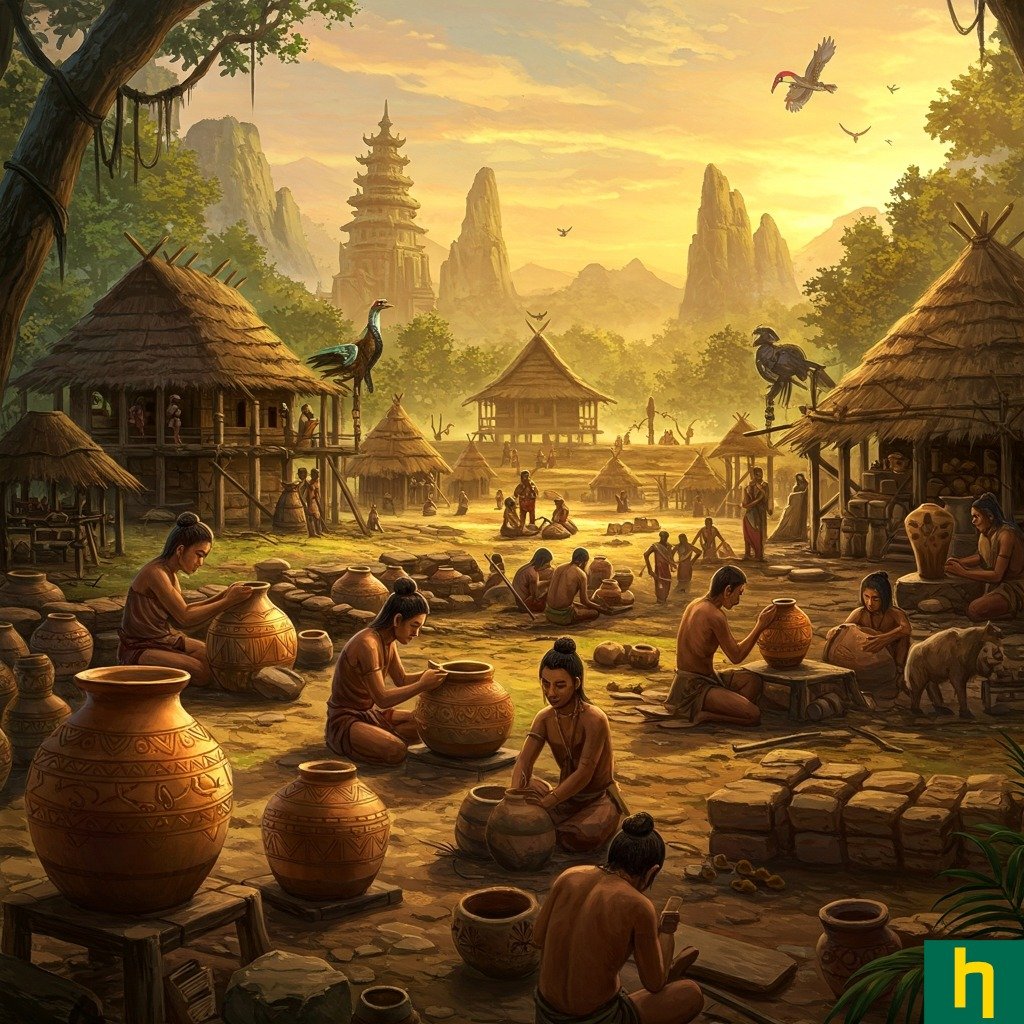Ban Chiang in the hot and humid Northeast Thailand is as far away as you can be from the popular beaches of southern Thailand or the megacity of Bangkok. For the history-loving tourist, though, Ban Chiang archaeological site offers a fascinating look into SE Asia’s very own “cradle of civilisation”.
For too long, the story of humanity’s greatest leaps centred around the usual suspects: Mesopotamia, the Indus Valley, or the Pearl River Delta. But in the quiet heart of Udon Thani province, a discovery would unravel this tidy yet wrong historical thesis.
Ban Chiang, a UNESCO World Heritage site, isn’t just another dusty archaeological dig. It’s a site that, in the mid-1960s, burst onto the scene, forcing academics to rethink their understanding of humanity’s earliest triumphs.
Ban Chiang, Udon Thani’s Early Settlement

To truly appreciate Ban Chiang culture, you must first understand its geography. Located some 560 kilometres from Bangkok, Thailand’s sprawling northeastern Isan heartland has a rugged beauty and a culture distinct from the central plains or southern shores.
This isn’t busy Bangkok, nor the misty mountains of the North. Instead, the Khorat Plateau is an expanse of land that gently defines much of Isan. The plateau is a patchwork of rice paddies and low hills that burn in the tropical sun.
It’s this environment, shaped by monsoons and fed by tributaries flowing into the mighty Mekong River, that proved to be the ideal mix for an early Ban Chiang civilisation. The fertile soils, coupled with abundant water resources, suited the wet-rice cultivation that formed the backbone of this early society.
Approaching the Ban Chiang archaeological site itself, located in Nong Han district about 50 kilometres (31 miles) east of Udon Thani city, you’ll see the land gently rise. Unlike other UNESCO sites in Thailand, such as Ayutthaya or Sukhothai, the site isn’t a monumental ruin, but an oval-shaped mound, reaching about 8 meters high. But this unassuming mound holds secrets that have come to defy conventional wisdom.
History’s Accidental Revelation
Ban Chiang’s international unveiling began not with shovels and systematic surveys, but with a simple misstep in the simmering Isan heat of 1966.
Stephen Young, a Harvard University anthropology student, was in Thailand on a study trip. His mission was to record folk tales in the rural villages of Isan. One afternoon, whilst resting from the sun, he stumbled over what he described as “a small earthenware pot, its rim protruding from a dirt path.”
What followed was a moment of curiosity that would come to rewrite history. Young, possessing a natural archaeological sensibility, knew this wasn’t an ordinary piece of pottery. As he scraped away the soil, more fragments emerged, with distinctive swirling patterns. He collected samples and mailed them back to his mentor at Harvard, Chester Gorman.
Gorman immediately recognised the extraordinary nature of the find. While the Thai Fine Arts Department had listed Ban Chiang as an archaeological site as early as 1957, it was Young’s collection that propelled Ban Chiang onto the world stage. Initial dating delivered a bombshell; the pottery dated back as far as 4000-3400 BCE.
At the time, the prevailing archaeological dogma was that settled societies originated primarily in the Near East or China. The idea that a Bronze Age culture flourished independently, and so early, was astonishing. The findings challenged long-held biases, pushing scholars to re-evaluate their chronology for human development.
More rigorous radiocarbon dating in 1974-1975 refined the dates to a more conservative, yet still remarkable range of 2100 BCE to 200 CE. This accidental stumble was the catalyst needed to unearth one of humanity’s most compelling hidden chapters.
Unearthing a Prehistoric Masterpiece

To grasp the significance of the Ban Chiang archaeological site isn’t just to observe artifacts, but to reconstruct a whole historical thesis from the fertile plains of Isan. The continuous occupation of Ban Chiang, spanning over two thousand years, offers an unparalleled diary of human progress that we can interpret through its magnificent material culture.
Perhaps Ban Chiang’s most iconic prowess was in its pottery. Each pot, hand-coiled and paddled before decoration, possessed a unique character. These pieces weren’t just objects; they were expressions of identity. Many were found to be cherished grave goods and accompanied their owners into the spirit world.
Ban Chiang also unveiled extraordinary evidence of bronze metallurgy. For decades, archaeologists thought Southeast Asia’s metal tech was a later import from China. Ban Chiang changed all this. Archaeologists found crucible fragments, clay moulds, and pieces of slag, proving that inhabitants weren’t just users of bronze, but active producers of it.
From their crucibles emerged an array of artifacts: axes, spearheads, and other tools like fishhooks, along with bracelets, anklets, and rings adorned with intricate patterns.
The Rhythms of Daily Existence

However, Ban Chiang wasn’t just about grand artistic statements. It was grounded in the practicalities of an early agrarian society. Evidence of wet-rice cultivation, for example. The presence of rice husk temper in their pottery confirms that rice wasn’t just consumed but was integral to daily existence. Domesticated animals further supplemented their diet. Archaeological findings reveal bones of cattle, pigs, and chickens, suggesting a diversified, self-sufficient economy.
Burials and Beliefs
Some of the most important insights into Ban Chiang’s life come from its burial grounds. The practice of “residential burial”, where the deceased were buried directly beneath their dwellings, shows us their close connection with their ancestors. Archaeologists uncovered hundreds of graves, revealing elaborate artifacts placed with the deceased: infants cradled in large pottery, adults adorned with bronze anklets and bangles, surrounded by pots, some stacked around the body. Burial rituals also suggest a profound spiritual belief in an afterlife, where material possessions are crafted with care and skill.
A Village Woven From Wood and Ingenuity
While no grand stone structures remain, the clues of Ban Chiang paint a picture of organised village life. According to archaeologists, dwellings were raised on timber piles to protect from the severe flooding common on the Khorat Plateau.
Beyond dwellings, there’s also evidence of textile production. Spindle whorls point to the spinning of fibres into yarns of cotton and even silk. And carved ceramic cylinders are believed to have been used for applying dyes onto fabric.
There was an obvious flair of the Ban Chiang people: not just adorned with bronze, but with clothing and skin decorated with the very same swirling motifs seen on their pottery.
Ban Chiang’s Paradigm Shift in Prehistory
For decades, the dominant academic thesis rooted in Western and Sinocentric perspectives on metallurgy and social organisation originated in a few “cradles of civilisation”. Southeast Asia was seen as a cultural backwater waiting for enlightenment from its more “advanced” neighbours.
Ban Chiang shattered all this. The irrefutable evidence of sophisticated bronze production contradicts the idea that metalworking arrived late and through external influence. Ban Chiang forced experts to take off their China-colored glasses when looking at Southeast Asian prehistory.
This revelation cemented Ban Chiang’s status as a benchmark against which other prehistoric finds in Southeast Asia are compared. Its discovery sparked a surge of interest across the region, leading to the excavation of numerous other related sites.
In recognition of its significance, Ban Chiang was inscribed as a UNESCO World Heritage Site in 1992. This designation highlighted the emergence of an early agricultural society and the dawn of metal technology in Southeast Asia.
Unfortunately, its fame also brought challenges. The early, sensationalised dating in the 1970s, combined with the beauty of its artifacts, fueled a black market for Ban Chiang antiquities. Illicit digging and looting became a serious threat, with many artifacts making their way into private collections and museums.
Ban Chiang reminds us of the potential of the human spirit,
From a quiet corner of Thailand, Ban Chiang reminds us of the potential of the human spirit. For the history lover, it’s a destination promising a shift in perspective on the timeline of human civilisation.
Immersing Yourself in Ban Chiang’s Legacy
For the traveller seeking a profound encounter with history, a visit to Ban Chiang is a must. It’s a rewarding detour from Thailand’s more conventional tourist circuits. It’s a journey through time, offering a connection to a civilisation that shaped Southeast Asia’s prehistory.
Ban Chiang National Museum isn’t just a store of relics. As you step into its galleries, a stunning collection of pottery, each with its unique, swirling design, awaits. You’ll see the evolution of ceramic artistry from the earliest times to later intricate painted masterpieces. The Ban Chiang museum’s displays are exceptional, with detailed graphics and clear English explanations that bring history to life.
Bronze Age Technology
Beyond pottery, the museum also showcases the groundbreaking evidence of bronze working: crucible fragments, stone moulds, and finished bronze artifacts.
You’ll encounter skeletal remains and preserved tools. Ban Chiang archaeological museum also dedicates a section to the fascinating tale of Steve Young’s accidental stumble that put Ban Chiang on the map. It’s an engaging experience that successfully bridges the gap between ancient artifacts and living history.
The museum is open daily from 9:00 AM to 4:00 PM, with a nominal entrance fee (around 150 Thai Baht for foreigners), making it an accessible and essential first stop.
A short stroll from the museum leads you to the active archaeological site at Wat Pho Si Nai. Here you can descend into the excavation pits where the initial discoveries were made. It’s a deeply moving experience to stand at the edge of these pits. The Wat Pho Si Nai site is typically open longer than the museum, until 6:00 PM, and entry is free with a museum ticket.
For those with a deeper interest, you can also explore the nearby village of Ban Chiang itself. You’ll encounter local artists continuing the tradition of pottery making. Visiting the Ban Chiang archaeological site is a contemplative journey for all those who love to learn about the past. Prepare to be thrilled, enlightened, and moved by this exceptional window into the past.
A Legacy That Redefines Our Past
The brilliance of Ban Chiang paints a vivid picture of a peaceful, self-sufficient society that flourished for over two millennia. In an age where global connectivity blurs local distinctiveness, Ban Chiang reminds us of the stories etched into every landscape. So, as you plan your next extraordinary adventure, consider this journey to Thailand’s northeastern heartland. Immerse yourself in the history of Ban Chiang, and allow this UNESCO World Heritage Site to reshape your understanding of civilisation.
Ban Chiang FAQs
What is the Ban Chiang Archaeological Site?
The Ban Chiang Archaeological Site is a large, prehistoric earthen mound in northeastern Thailand, located in the Nong Han district of Udon Thani province. It is considered one of the most important prehistoric settlements in Southeast Asia and was designated a UNESCO World Heritage Site in 1992 for its unique testimony to a vanished civilisation.
What is the significance of the archaeological discoveries at Ban Chiang?
The discoveries at Ban Chiang have helped to rewrite the prehistory of Southeast Asia. The site provides early evidence of wet-rice cultivation, the domestication of farm animals, and sophisticated ceramic and bronze tool-making technology, challenging the previous belief that these advancements were introduced from other cultures, like China or India, at a much later date.
What are the key artifacts found at Ban Chiang?
The most famous artifacts from the site are the ancient red-painted pottery with distinctive abstract spiral and geometric designs. Other important discoveries include a variety of bronze and iron artifacts such as tools, weapons, and personal ornaments like bangles. These finds offer a detailed look into the advanced and peaceful society that once thrived there.
How old is the Ban Chiang civilisation?
The archaeological evidence and scientific dating methods, such as radiocarbon dating, suggest that the Ban Chiang civilisation was continuously occupied from as early as 1,500 BCE until around 200 AD. The earliest evidence of bronze working has been dated to approximately 2000 BCE, placing the site at the centre of the region’s Bronze Age.
How can I visit the Ban Chiang Archaeological Site today?
Visitors can explore the site at the Ban Chiang National Museum in Udon Thani province, which houses many of the artifacts and provides detailed exhibits about the history and significance of the

